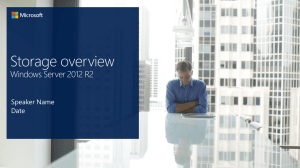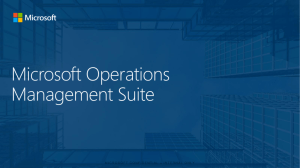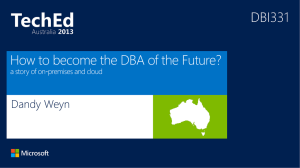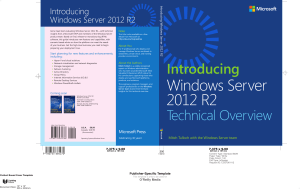Storage overview Windows Server 2012 R2
advertisement
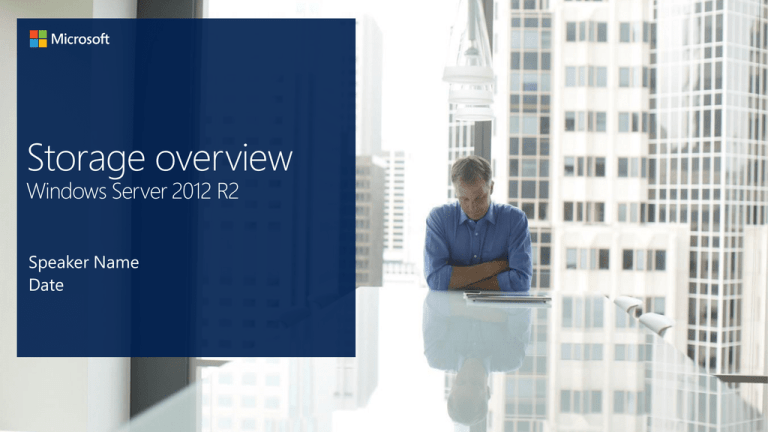
Storage overview Windows Server 2012 R2 Speaker Name Date Windows Server Microsoft Azure Windows Server Microsoft Azure Flat or shrinking IT budgets even as business expectations increase. “Keeping the lights on” mandate reduces agility to address app owners’ needs. Efficient datacenter operations across entire customer base. Need to offer differentiated services to customers. Enterpriseclass Simple and cost-effective Complexities due to diverse datacenter infrastructure. End user pressure to enable access to corporate information from a variety of devices. Application focused User centric High performance and resiliency at a fraction of the cost IT demands Less expensive, enterprise-class storage solution Guaranteed high levels of Service Level Agreement (SLA) Efficient management of storage resources Windows Server 2012 R2 delivers High-performance storage on industry-standard hardware. Continuous application availability and robust recovery. Comprehensive storage management and backup. + + + • • • • • • • VHDX Increased flexibility through Live Migration of VM Storage • Move virtual hard disks attached to a running virtual machine • Manage storage in a cloud environment with greater flexibility and control • Move storage with no downtime • Update physical storage available to a virtual machine (such as SMB-based storage) • Windows PowerShell cmdlets Disk Disk Reads writes contents are andmirrored; writes are copied gooutstanding to to new new Reads and writes go to the source VHD changes destination are replicated VHD SMB client Reads and writes go to new destination VHD Host running Hyper-V App Buffer SMB Buffer Virtual machine SMB Buffer Source device Adapter Buffer Target device Adapter Buffer 28 Offloaded Data Transfer (ODX) Virtual fibre channel in Hyper-V Thin and trim provisioning • • • • • • • Access Fibre Channel SAN data from a virtual machine • Unmediated access to a storage area network (SAN) • Hardware-based I/O path to virtual hard disk stack • N_Port ID Virtualization (NPIV) support • Single Hyper-V host connected to different SANs • Up to four Virtual Fibre Channel adapters on a virtual machine • Multipath I/O (MPIO) functionality • Supports Live migration • • • • • • • • • • • • • • • • Microsoft Azure Third-party cloud 1. 2. 3. 4. 5. Replicate Hyper-V VMs from a Primary to a Replica site Replicate to 3rd Location for Extra Level of Resiliency • Once a VM has been successfully replicated to the replica site, replica can be replicated to a 3rd location • Chained Replication • Extended Replica contents match the original replication contents • Extended Replica replication frequencies can differ from original replica • Useful for scenarios such as SMB -> Service Provider -> Service Provider DR Site Orchestrate protection and recovery of private clouds • Protect important services by coordinating replication and recovery of VMM-managed private clouds • Automates replication of VMs within clouds between sites • Hyper-V Replica provides replication, orchestrated by Hyper-V Recovery Manager • Can be used for planned, unplanned and testing failover between sites • Integrate with scripts for customization of recovery plans Orchestrate protection and recovery of private clouds • Protect important services by coordinating replication and recovery of VMM-managed private clouds • Automates replication of VMs within clouds between sites • Hyper-V Replica provides replication, orchestrated by Hyper-V Recovery Manager • Can be used for planned, unplanned and testing failover between sites • Integrate with scripts for customization of recovery plans Get-Command –module [ ] SMBshare NFS FileServerResourceManager DFSN Deduplication iSCSITarget Storage FailOverClusters • • • • • • • • • • • • • • • • • • • • • • • • • Private Cloud Storage Windows Server file-based storage clusters + Storage Spaces System Center (DPM) Windows Azure Backup Hyper-V Replica & 3rd Party Solutions (for apps) Hybrid Cloud Storage Flat or shrinking IT budgets even as business expectations increase. “Keeping the lights on” mandate reduces agility to address app owners’ needs. Efficient datacenter operations across entire customer base. Need to offer differentiated services to customers. Enterpriseclass Simple and cost-effective Complexities due to diverse datacenter infrastructure. End user pressure to enable access to corporate information from a variety of devices. Application focused User centric Enterprise-class. Simple and cost-effective Application focused User centric Best-in-class performance and scale for Microsoft workloads SMB traffic offload to RDMA-capable NICs for dramatic performance improvements Complete VM portability between Windows Server and Microsoft Azure without the need for VM conversion Always-on remote access to corporate information from trusted devices Flexible guest clustering options for file and block storage with shared VHDX files that preserve dynamic memory, live migration and storage live migration for guest virtual machines. Same development model between Windows Server and Microsoft Azure Industry-leading support for 64-node clusters and 8,000 VMs per cluster 64 TB VHDX virtual disk with online resize for dynamically growing and shrinking the VHDX file Hyper-V Network Virtualization and multi-tenant VPN gateway for inbox software-defined networking (SDN) solution Integration with Windows Azure Backup for reliable and cost-effective backup to the cloud. VDI storage de-duplication Common development tools between Windows Server and Microsoft Azure for a rich and complete environment to build applications on-premises and for the cloud Consistent, inbox Windows experience for remote users virtually anywhere on any device Unified application and device management with common identity on-premises and in the cloud Granular, policy-based data protection and regulatory compliance http://www.microsoft.com/en-us/server-cloud/evaluate/trial-software.aspx http://www.microsoft.com/systemcenter http://systemcenter.pinpoint.microsoft.com http://blogs.technet.com/server-cloud Microsoft Confidential 63
